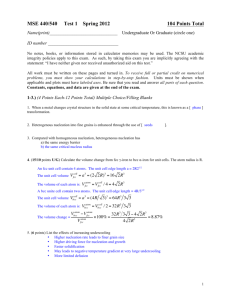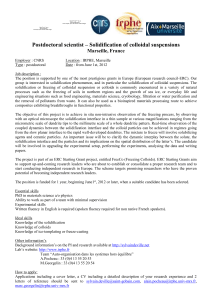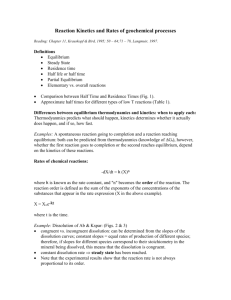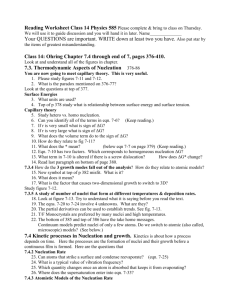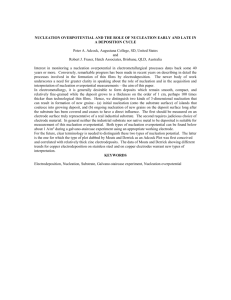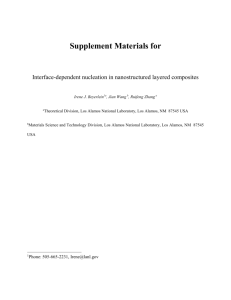solidification
advertisement
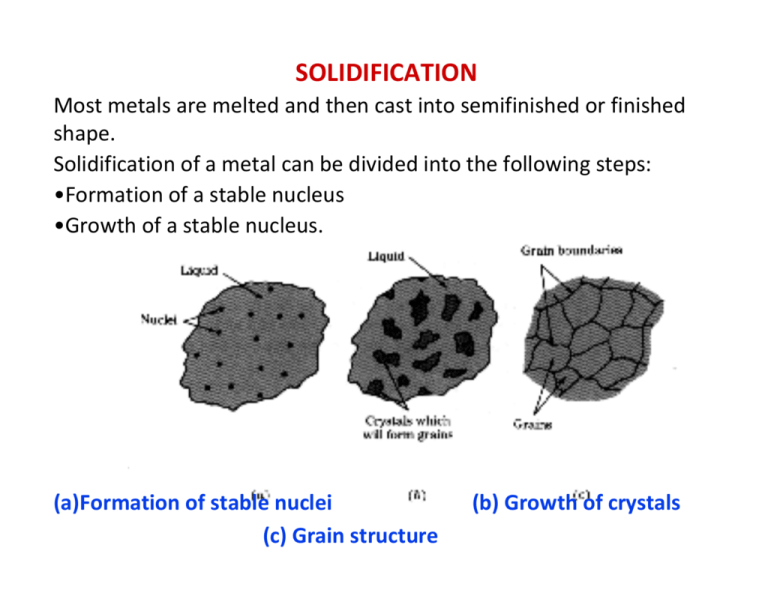
SOLIDIFICATION Most metals are melted and then cast into semifinished or finished shape. Solidification of a metal can be divided into the following steps: •Formation of a stable nucleus •Growth of a stable nucleus. (a)Formation of stable nuclei (c) Grain structure (b) Growth of crystals Polycrystalline Metals In most cases, solidification begins from multiple sites, each of which can produce a different orientation. The result is a “polycrystalline” material consisting of many small crystals of “grains” Each grain has the same crystal lattice, but the lattices are misoriented from grain to grain Cooling Curves Undercooling ‐ The temperature to which the liquid metal must cool below the equilibrium freezing temperature before nucleation occurs. Recalescence ‐ The increase in temperature of an undercooled liquid metal as a result of the liberation of heat during nucleation. Thermal arrest ‐ A plateau on the cooling curve during the solidification of a material caused by the evolution of the latent heat of fusion during solidification. Total solidification time ‐ The time required for the casting to solidify completely after the casting has been poured. Local solidification time ‐ The time required for a particular location in a casting to solidify once nucleation has begun. Solidification of Pure Metals Temperature remains constant while grains grow. Some metals undergo allotropic transformation in solid state. For example on cooling bcc δ‐iron changes to fcc γ‐iron at 1400 C, which again to bcc α‐ iron at 906 C. Figure 8.12 (a) Cooling curve for a pure metal that has not been well inoculated. Liquid cools as specific heat is removed (betweens points A and B). Undercooling is thus necessary (between points B and C). As the nucleation begins (point C), latent heat of fusion is released causing an increase in the temperature of the liquid. This process is known as recalescence (point C to point D). Metal continues to solidify at a constant temperature (T melting). At point E, solidification is complete. Solid casting continues to cool from the point. (b) Cooling curve for a well inoculated, but otherwise pure metal. No undercooling is needed. Recalescence is not observed. Solidification begins at the melting temperature Solidification of an Alloy The alloys normally solidify in a temperature range Cooling Curves are used to produce phase diagrams Driving force: solidification AL ⇒ AS For the reaction to proceed to the right ∆GV must be negative. • Writing the free energies of the solid and liquid as: GVS = HS ‐ TSS GVL = HL ‐ TSL ∴ ∆GV = ∆H ‐ T∆S At equilibrium, i.e. Tmelt, then the ∆GV = 0, so we can estimate the melting entropy as: ∆S = ∆H/Tmelt = ‐ L/Tmelt where L is the latent heat (enthalpy) of melting. • Ignore the difference in specific heat between solid and liquid, and we estimate the free energy difference as: ∆GV ≈ ‐ [L – T (L / Tmelt)] = ‐ L ∆T / Tmelt Properties of metallic melts ‐No long‐range but short‐range order. ‐Almost as dense as crystal: Δρ of order of 1% ‐Atoms highly mobile: η(Tm ) ~ ηwater ‐ Entropy of melt SL>entropy of crystal SS (disorder, more degrees of freedom) ‐Enthalpy of melt HL > enthalpy of crystal HS (imperfect binding). GS, GL linear near Tm ….. ΔGSL = α ΔT Undercooling is needed : ΔT= Tm ‐ T α : material constant Sketch of the course of the Gibbs free energy G and the enthalpy H of liquid (melt) L and solid S near the melting temperature Tm. Observation: Solidification not at Tm! Undercooling ΔT is required due to nucleation! Solidification = nucleation + growth of nuclei NUCLEATION The two main mechanisms by which nucleation of a solid particles in liquid metal occurs are homogeneous nucleation and heterogeneous nucleation. Homogeneous Nucleation Homogeneous nucleation occurs when there are no special objects inside a phase which can cause nucleation. For instance when a pure liquid metal is slowly cooled below its equilibrium freezing temperature to a sufficient degree numerous homogeneous nuclei are created by slow‐moving atoms bonding together in a crystalline form. Consider the free energy changes when some atoms in the liquid collapse and agglomerate to form a solid of radius r. The energy changes involve two terms: (a)The chemical free energy change associated with the transfer of atoms from liquid to solid state (ΔGv); (b)the interfacial energy (γ)due to the creation of new interface (liquid‐ solid interface)! * Assume that ΔGv is the change in free energy per unit volume and ΔGT is the total Free energy change, r is the radius of the nucleus 4π r 3 ⇒ Δ GT = Δ G V + 4π r 2 γ 3 2γ ⇒ r0 = − Δ GV dΔ GT dr = 4π r02 Δ G V + 8π r0 γ = 0 r = r0 4πγ r02 16 πγ 3 ⇒ Δ G T ( r0 ) = = 2 3 3 Δ GV • r0 : critical radius; * for r < r0 : the growth of the droplet ⇒ ΔGT ↑ ⇒ the embryos should shrink and disappear! * for r > r0 : the growth of the droplet ⇒ ΔGT ↓ ⇒ the nuclei could steadily grow! So, what would make a embryo go beyond the critical size to become a nuclei? Actually it is the local fluctuation of density! The probability for an event to occur is : ≈ exp⎛⎜ ΔGT ⎞⎟ ⎝ kT ⎠ γ The treatment to obtain the free energy changes as a function of atoms in solid is the same as previous: The energy changes involve two terms: (a) the chemical free energy change associated with the transfer of atoms from liquid state to the solid state (Δgls) ; (b) the interfacial energy (γ) due to the creation of new interface (liquid solid interface)! The above equation can be written as a function of the number of atoms n. η is a shape factor that links n to the area of the nuclei. ⇒ Δ G n = Δ g ls n + ηγ n 2 / 3 Q ∴ Δ G nc = ηγ n 2/3 c dΔGn dn 3 = 4η γ 3 3 Number of atoms n in a sphere ⇒ 4π r 2 = 4π (3v l n 4π ) 2/3 = Δ g ls + n = nc 27 Δ g ⎛ 2ηγ 2 ηγ n c−1 / 3 = 0 ⇒ n c = ⎜⎜ sl 3 ⎝ 3Δ g ⎞ ⎟⎟ ⎠ 3 ls 2 n = 4π r 3 3v l ⇒ r = (3v l n 4π ) 1/ 3 = ( 36 π )1 / 3 ( v l ) 2 / 3 n 2 / 3 ⇒ η = ( 36 π )1 / 3 ( v l ) 2 / 3 The number of embryos of size nc is (with N the number of atoms in the liquid) N n = Ne − Δ G nc / kT as treated before, for small undercooling, the Δgls : Δg ls = Δh ls − TΔs ls = Δhm − T ∴ Δ G nc Δhm ΔT = Δhm Tm Tm 4η 3γ 3Tm2 1 A = = 2 2 2 ΔT 27 Δ h m Δ T ΔGV = ΔH f ΔT Tm 2γ Tm ⇒ r0 = ΔH f ΔT Where: ΔHf = Latent Heat of fusion ΔT = amount of undercooling at which the nucleus form Heterogeneous Nucleation Heterogeneous nucleation is the nucleation that occurs in a liquid on the surfaces of its container, insoluble impurities or other structural material (catalyst) which lower the critical free energy required to form a stable nucleus. γL-S Liquid γL-C θ γL-C = γS-C + γL-S Cosθ Solid γS-C ro Catalys t Heterogeneous nucleation facilitated by: ‐ similar crystal structure (low misfit strain) ‐ chemical affinity ‐ rough surface (reduced melt/nucleus surface) Grafting of melt with small particles ⇒ fine grains. Note: The critical radius, r*het, of a heterogeneous nucleus is much larger than the critical radius, r*hom, of a homogeneous nucleus of the same phase. For the same critical radius the heterogeneous nucleus contains far fewer atoms. Mathematical Considerations for Heterogeneous Nucleation Consider a hemispherical cap. Now we have three surface energies γL‐S: solid‐liquid ; γS‐C: solid‐ mould/“catalyst” and γL‐C: mould/“catalyst”‐liquid The surface energy component is given by: γ Total = AreaS − L × γ S − L + AreaS − C × γ S − C − AreaS − C × γ L − C γ Total = 2πr 2 (1 − cosθ ) × γ S − L + πr 2 (1 − cos 2 θ )× (γ S − C − γ L − C ) First term is surface area added at the new liquid‐solid interface Second term represents replacing catalyst/liquid surface with solid/catalyst surface Wetting angle θ comes from force balance of interfacial energies cosθ = (γ L −C − γ S −C ) = wetting _ angle γ L−S The chemical component to ΔGV 2 4 3 ⎛ (2 + cosθ )(1 − cosθ ) ⎞ ⎟ × ΔGV ΔGV = −Volume × ΔGV = − πr ⎜⎜ ⎟ 3 ⎝ 4 ⎠ ΔGv is the same as in the homogeneous case (the thermodynamic driving force for phase change) ΔGTotal cosθ = ΔGTotal 2 4 3 ⎛ (2 + cosθ )(1 − cosθ ) ⎞ ⎟ × ΔGV + 2πr 2 (1 − cosθ ) × γ S − L + πr 2 1 − cos 2 θ × (γ S − C − γ L − C ) = − πr ⎜⎜ ⎟ 3 ⎝ 4 ⎠ ( ) (γ L −C − γ S −C ) γ L−S 2 ⎛ 4 3 ⎞⎛⎜ (2 + cosθ )(1 − cosθ ) ⎞⎟ 2 = ⎜ − πr × ΔGV + 4πr × γ S − L ⎟⎜ ⎟ 4 ⎝ 3 ⎠⎝ ⎠ dΔ GT dr = 4π r Δ G V + 8π r0 γ = 0 2 0 r = r0 2γ ⇒ r0 = − Δ GV rCritical is the same as the homogeneous case, but we only need the cap and hence the number of atoms needed for the nucleus is very small. S(θ) is a fraction. Plug in some values of θ and you’d get • θ=90°, S(θ)=0.5; • θ=60°, S(θ)=0.16; • θ=30°, S(θ)=0.013 This means the barrier for nucleation is much less than the homogeneous case Growth of nuclei ‐ Pure metals Crucial: direction of heat flow including heat of crystallization. (a) The heat is dissipated through the crystal, i.e. the growing crystal is colder than the melt. Here a solid bulge into the liquid would melt again because the temperature in the bulge is above Tm . Therefore, one obtains a stable flat solidification front (facetted) and globular grains. (b) For a strongly undercooled melt the heat of crystallization can also be dissipated through the melt. Here any solid bulge leads to a further reduction of the temperature in the bulge. Therefore, the flat interface is unstable and branched crystalline projections, so‐called dendrites are formed. a) Heat dissipation through crystal ⇒ stable S/L interface, globular grains b) Heat dissipation also through melt ⇒ unstable front: Dendrites: grow in nearly crystallographic directions (due to anisotropic mobility of S/L front). Residual melt between dendrites: heated by heat of crystallization ⇒ slow solidification Thermal dendrites can form from small perturbations at liquid/solid interface: δT <0 ⇒ growth into colder liquid i.e. δx ⇒ unstable interface as ΔT larger so greater ΔG ⇒preferred growth in favored crystallographic directions, often <100> in many metallic alloys. Metallic alloys: partition coefficient During the solidification of metallic alloys, solute partitioning (redistribution) occurs and this is the more usual cause of dendritic growth even when the temperature gradient in the liquid δT The partition coefficient k is defined according to cSL cS k= = cLS cL δx <0 Alloys : Constitutional Undercooling A phase diagram with linear solidus and liquidus lines. The distribution coefficient k0 is defined as cS/cL. The lack of diffusion in the solid and limited diffusion in the melt lead to an enrichment of solute atoms in the melt at the S/L interface. The shape of cL(x) depends on the diffusivity in the melt and the magnitude of convection, which is much more effective in redistributing solute atoms than diffusion except near the S/L interface where grad c is large. The solute enrichment at the S/L interface leads to a reduction in the liquidus temperature TL. Between x = 0 and x = xL one has TL(x) < T(x), i.e. the alloy is undercooled. solid Tm liquid V Heat flow S Stable Interface Freezing: Solidification is controlled by the rate at which the latent heat of solidification can be conducted away from the interface. => ∇T is important! * heat flow away from the interface = the heat flow from the liquid + the latent heat generated at the interface (with a velocity V)! dTS dTL KS = KL + VΔhm dx dx K: thermal conductivity, Tm V Heat flow Limited diffusion in S and L ⇒ pile up of solute atoms in melt at S/L interface ⇒ TL(x) < T(x) near interface (²constitutional undercooling²) below critical T‐gradient ⇒ instability of S/L interface ⇒ dendrites or cellular structure When heat is conducted away from the solid => more heat is conducted into the protruding solid => growth rate is decreased => protrusion will disappear! When heat is conducted away from the liquid, i.e., solid growing into supercooled liquid => the negative temperature gradient in the liquid => more negative => heat is remove more effectively from the tip of the protrusion => protrusion grows (unstable) => dendritic growth! Low accommodation factor surface || interface => a stable interface! solid Tm liquid V Heat flow Tm V Heat flow Dendritic Growth (thermal dendrite): Dendrite growth occurs when the liquid has high enough supercooling. Primary dendrite. Dendrite growth direction: high accommodation factor surface. The heat released from solidification could raised the temperature around the dendrite wall). => temperature gradient (TA > TB), if the gradient is large enough, i.e. heat is effectively removed from the liquid => Secondary dendrites. If the heat is not effectively removed from the liquid => temperature of liquid ↑ => nucleation of a supercooled liquid (recalescence). In the absence of cooling from outside, a large supercooling is required for complete dendritic freezing. The amount of solid that forms from a supercooled liquid without heat removal by the surrounding is f S = C p ⋅ ΔT Δhm Δhm: heat released from solidification; Cp×ΔT: the heat that could be accommodated by the liquid and solid; fs: fraction solidified Freezing in Alloys : Consider an isomorphous alloy system at T1. Solid with composition a is in equilibrium with liquid with composition b. CS KS ≡ Cl b T1 a A B Cl CS Liquid with composition b δx Heat flow direction T1 a Initially solidification occurs => solid with less B atoms is T2 formed => extra B in the liquid near the S/L interface (enriched, say d point) => the liquid require even lower temperature T2 to freeze and the corresponding solid will freeze with composition c => the process continues until the A liquid in the S/L interface has the composition of f and freezing temperature of T3. b c e d f T3 B The solid will have the composition of e which is equal to b. A steady state is reached. Two factors determine the shape of the composition‐distance curve: (1) freezing rate; (2) diffusivity No convection is considered to redistribute the solute atoms in liquid; if convection is considered => the solute concentration at the S/L interface ↓. d b c a L f b a L f b a L • Nucleation; – Homogeneous nucleation: very pure metal, substantial undercooling (0.2Tm) – Heterogeneous nucleation: nucleation agents (5OC undercooling) • Grain growth – Planar: pure metal – Dendritic: solid solution • Grain size – depends on number of nuclei and cooling rate. Supersaturated Solutions • If the liquid is just at the freezing point, only a few molecules stick, because they have comparatively high energy • As the liquid is cooled, more molecules can form into nuclei. • When the nucleus is big enough (because of undercooling) the supercooled liquid suddenly changes to a solid. • Metals often experience undercooling of 50 to 500 degrees C • Homogeneous nucleation usually only occurs in the lab. • Impurities provide a “seed” for nucleation • Solidification can start on a wall. • It’s like cloud seeding, or water condensing on the side of a glass. • Adding impurities on purpose is called inoculation • Nucleation begins • Chill Zone • Columnar Zone (a) There may be dendrites in the columnar zone (b) Grains grow in preferred directions • Equiaxed Zone Continuous Casting and Ingot Casting Ingot casting ‐ The process of casting ingots.This is different from the continuous casting route. Continuous casting ‐ A process to convert molten metal or an alloy into a semi‐finished product such as a slab. Figure 8.21 Summary of steps in the extraction of steels using iron ores, coke and limestone. (Source: www.steel.org. ) Figure 8.23 Secondary processing steps in processing of steel and alloys. (Source: www.steel.org. ) Continuous casting Predominant process for large scale steel production (variants such as Hazlett process for aluminum alloys). Note the mould may be oscillated to improve surface quality and to minimise “breakout” due to large internal sump. Electromagnetic stirring improves homogenization and also refines final grain size. Figure 8.22 Vertical continuous casting, used in producing many steel products. Liquid metal contained in the tundish partially solidifies in a mold Rapid solidification (melt spinning) Cooling rate can be 104 – 107 K/s‐1 and hence can achieve amorphous (non‐crystalline) structures in metals (metallic glasses). Fe‐Ni alloys can be used for magnetically soft transformer cores and also for tape recorder heads. Zone Refining The redistribution of solute ahead of the S/L interface can be used to purify the metal. Zone refining, e.g. of silicon, with a repeated sweeping in one direction, leading to purification (elements for which k > 1 would be swept in the other direction). By moving the furnace to and fro, one can obtain zone leveling.
